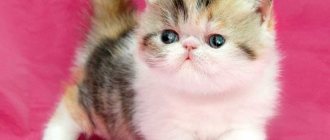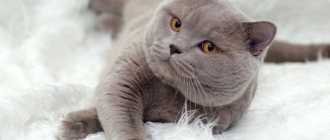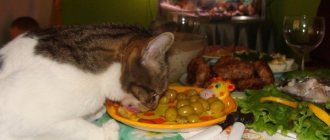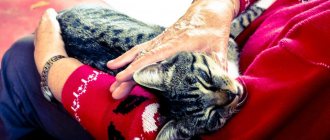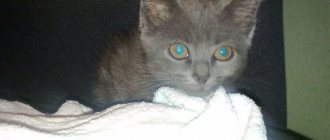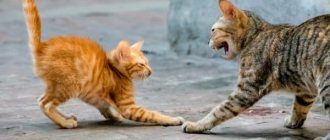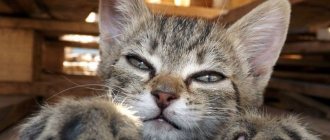You can’t describe the character of a British cat in a few words. It’s the same as saying about Napoleon’s life “he led France.” Only, the British are not French. They are proud, sometimes arrogant. We are talking about cats, about them - cats of the British breed.
Only this fact does not mean that representatives of the breed never want to be petted. They want it, but when they need it, and not at the moment when the owner takes it into his head. This cat is a personality. He has an opinion that must be taken into account. To understand what kind of character British cats have, you need to watch them a little, or better yet, live in the same house for several weeks.
Features of the appearance of the breed
Representatives of the British breed are distinguished by their stockiness and unusual plush fur. Pets come in medium and large sizes. They are beautifully built and have good muscles. The fur does not adhere to the body, which is why pets look like plush toys. At the same time, it has a uniform length; often the undercoat has a darker color than the main shade of the coat. The limbs are short but strong.
The British breed is characterized by a large head with pronounced cheekbones. The eyes of the pets are wide open, the nose is straight, the ears are quite short, because of this the muzzle looks more rounded.
The color of the British is not only blue. Although mostly people have pets of this shade. Cats may not be the same color; uneven coloring of the coat is also allowed. Each shade has several variations, for example, lilac is divided into three types: light, medium, dark.
The British breed inspired Lewis Carroll to create the Cheshire Cat. The character was based on the wide and slightly smug muzzle of the British.
In fact, according to the breed standard, at least thirty types of colors are known:
- black;
- white;
- creamy;
- chocolate;
- lilac;
- ginger;
- tortoiseshell;
- marble;
- chinchilla;
- brindle;
- mackerel;
- smoky;
- tabby;
- spotted.
Tender and affectionate British chinchilla
The British Chinchilla is a variety of the British breed that was created by crossing the British and Persian breeds. Usually this breed is chosen by those who are captivated by the beauty of the British, but are confused by their rebellious nature.
The chinchilla is people-oriented, has a good disposition and an easy-going character, which was passed on to it from the Persians, and it inherited intelligence and intelligence from the British.
Representatives of this breed love to cuddle and play with their owner; they will be able to establish relationships with all family members, even children, as well as animals. It is these character traits and qualities that make chinchillas a favorite.
British cats are distinguished by aristocracy and arrogance, independence and touchiness; they rarely show their feelings, so they can rarely be seen in an aggressive state or affectionate towards their owner. When getting a cat of this breed, you need to remember that it will always consider itself equal to a person.
Tea dictionary
| Aroma | Aroma |
| Boling water | Boiling water |
| Brew | Welding |
| To brew tea | Brew tea |
| Ceylonese tea | Ceylon tea |
| China | 1) China 2) Porcelain |
| China tea | Chinese tea |
| Cup | Cup |
| Curd | Kurd, custard |
| Darjeeling | Darjeeling (type of tea) |
| Earl Gray | Tea with bergamot |
| Green tea | Green tea |
| Herbal tea | Herb tea |
| Indian tea | Indian tea |
| Kettle | Kettle (for boiling water) |
| Lump (of sugar) | Sugar cube) |
| Milk | Milk |
| Mint tea | Tea with mint |
| Oolong | Ulung (type of tea) |
| Saucer | Saucer |
| To stir | Mix |
| Scone | Scone, classic English muffin |
| Strong tea | Strong tea |
| Sugar | Sugar |
| Taste | Taste |
| Tea house, tea shop | Tea house, teahouse |
| Tea leaves | Tea leaves |
| Tea strainer | Tea strainer |
| Teapot | Teapot, teapot |
| Teaspoon | Tea spoon |
| Weak tea, watery tea | Weak tea |
| White tea | White tea |
Character traits
The character of the British is formed before one and a half years. If you miss time, it will be difficult to re-educate the cat.
The British breed has a special temperament. Cats do not tolerate humiliation and rudeness. With the right approach, they behave in a dignified manner, do not destroy the house, do not bite, or spoil things. You cannot limit their freedom by trying to grab them and carry them in your arms all the time. If the owner shows aggression towards the pet, then in the future the animal will hide and may even refuse food.
The pet will not show its owners weaknesses. He will not take revenge, like representatives of another breed, by tearing off wallpaper or ruining shoes. The British may spend a lot of time at home alone. But, despite their independence, they need attention and affection.
Representatives of the British breed are extremely patient; they do not react to minor mischief. Therefore, they get along well with all the inhabitants of the house. But if a cat is hurt, it will defend itself by using its teeth or claws.
About activity
The character of British kittens, like cats, can actually be reserved and sometimes even cold, but this does not in any way affect their activity. The British sleep a lot, but in their free time they will do what they want: run, jump, play. The exception in this case is only older representatives of the breed. Pets that have access to the street are more active. They are interested in everything around them: leaves, butterflies, flowers, so cats can spend hours on end outside. If there are several cats in the family, then additional activity will be provided. This is very good, since active animals have much fewer health problems.
Important! To prevent your cat from lying around in the apartment, you should play with him from time to time and offer him some options for useful ways to spend his waking hours.
How to raise a cat - habit formation, punishment, praise
Habits, unlike character, are formed throughout the pet’s life. Therefore, owners, with a little effort, can raise a cat correctly. The main thing is to immediately let your pet know who is in charge in the house.
The British are considered very clean. Kids imitate their mothers in everything, adopting her good manners. So, in order to accustom a kitten to the tray, a couple of days are enough. Adults regularly wash themselves and clean their fur. But at the same time, they don’t like it when their owners start fiddling with their fur.
Bad habits
British cats love to drop objects from heights. They like to watch the process of falling. As soon as the owners notice this prank, they should immediately scold the animal. To wean your pet from climbing into prohibited places, you need to treat the surfaces with a special product.
A kitten under four months of age may bite and scratch as it is teething. If this continues into adulthood, then this indicates improper upbringing. Therefore, it is worth initially giving the British toys that can be bitten instead of the owners’ hands.
The most harmless bad habit is checking bags and packages. It is difficult to wean your pet off of this, but it is worth scolding him for such tricks so that a reflex is developed.
Should a Briton be punished or praised?
If a pet has committed an offense, then you need to scold it immediately. Otherwise, he will not understand the essence of the claims. Moreover, the British will harbor a grudge and prefer to be as far away from you as possible.
The carrot and stick rule works with animals, as with people. That is, the animal will develop reflexes not only to punishment, but also to praise. It is advisable to notice positive changes in the cat’s behavior by talking about it out loud.
Will it catch mice?
Following from history, British cats were specially bred to catch rats and mice. For successful hunting, breeders wanted to achieve a thick and short coat, so that it would be difficult for rodents to bite and injure the little catcher.
All representatives of this breed catch mice. This is genetically embedded in them. But in city apartments, as a rule, there is no opportunity to hunt at all.
Some owners take their British Shorthair cat with them to the countryside. There they catch all the mice in the area within a week. They most often bring their prey to the owner. When the rodents run out, the hunt begins for frogs, large insects, and birds. Cats are more graceful and passionate in hunting than cats.
The British are born mousecatchers.
Aggressive cat: what to do and where to run
Cats are very sensitive creatures with a subtle psychology, so their behavior is significantly influenced by external factors, especially strong emotions such as fear.
A cat that is afraid of something takes a characteristic pose - it presses its ears tightly to its head and moves them back, presses its head and body to the ground, tries to become more invisible, in many cases the animal simply tries to run away.
If it doesn’t run away, it tries to defend itself. A cat that is ready to defend itself looks like this - it raises its paws and swings them, makes sounds similar to spitting, hisses, its fur stands on end (especially on the tail, head and back), its back arches and the animal moves sideways forward, so a cat tries to show its superiority (including in size) and intimidate the enemy.
In most cases, fear is the main cause of aggression in cats. If your pet is timid, you should never deliberately provoke fear; you should also ask your friends and acquaintances to approach the animal slowly, not abruptly, and say kind words as they do so. Only in this way can possible aggression on his part be neutralized.
If the cat is ready to attack, is aggressive, you can spray water on it from a spray bottle, this will cool its ardor. If an animal scratches a smooth surface out of despair, it means that it has lost control of the situation. In this case, you need to put some kind of rug on the cat so that she can sharpen her claws on it, or wrap her in a warm cloth - this way the cat will calm down faster.
Another reason for cat aggression is defense of territory. If there are several animals living in your home, especially if you are the owner of several cats that have reached sexual maturity, they may begin to fight for leadership. To prevent this from happening, introduce the cats correctly in the first days.
The animal that lived with you before should definitely receive more attention - this way it will not feel threatened and will not become jealous. As a rule, cats that live together eat from the same bowls and use the same litter box, but this can cause aggression. Cat utensils should be separated as soon as you notice that the animals are demonstratively avoiding the litter box or fighting around the bowls.
Different smells of animals can cause them to fight, so the manifestation of aggression of one pet towards another can be reduced by bathing them with the same shampoo or spraying them with the same cologne.
Neutered cats, as a rule, are less aggressive, and even sworn enemies can be reconciled. But it is better to castrate animals between the ages of seven months and 1 year, until they acquire the habit of showing aggression and marking territory.
Often those who keep cats confuse their bites with aggression. Small kittens may bite you because their jaws itch (due to teething). Invite them to chew bones, but only those that they cannot chew, or large pieces of meat. Never feed bones from small animals and birds, or chicken bones, as kittens can chew them, causing damage to the gastrointestinal tract.
Often, when the owner tries to pet his pet, he may begin to bite, especially if you want to scratch the cat’s tummy (the stomach for cats is the most vulnerable place, if the animal allows you to scratch its tummy, it means it is subordinate to you and completely trusts you). However, this does not always mean that the cat is aggressive; most likely, your pet is simply not in the mood for communication at the moment or she does not like your affection.
Under no circumstances should you hit cats that show aggression - this will only make the situation worse. If possible, you need to eliminate the cause of the aggression and cool the animal’s ardor with a stream of water.
The following method may also help. You've probably seen how cats behave during fights (swinging their paws at each other, hissing) or mother cats with their children (ruffling them and holding them by the withers). You must do the same - lightly shake the animal by the scruff of the neck, lightly tap it on the nose with your finger, imitate the waving of cats' paws during a fight, hiss at it menacingly and be sure to look the cat in the eyes, since the one who looks away first will “lose” - These are the cat “rules”. You must ensure that your pet looks away, he will become somewhat confused, begin to hesitate, may begin to leave or lick himself - this all means that the animal has recognized you as the leader.
Did you like the article? Click the button and share with your friends! Let there be more happy people and cats!
brit-cats.ru
Reviews from British cat owners
Many owners of this breed point out that the British cat has become popular in our time due to the fact that it does not require attention to it. The animal is relatively passive and calm, so it is an ideal keeping option for busy people.
It is important to know! If there are people with allergies in the house, then it is better not to buy a long-haired breed.
When the animal reaches 7-8 months of life, it begins to shed. This process is accompanied by the replacement of the old coat with a new one, so quite a lot of hair comes out, especially hair from the undercoat. It is not possible to cope with such a problem even when the wool is combed daily.
The most important thing is that the British cat is an animal with character, so it should be raised, as they say, “from scratch,” that is, from early childhood. Before you start a “British” home, you should think about purchasing all the necessary accessories and think through all the nuances of its contents. The cat must have its own special bed or house, as well as a closed plastic tray for the toilet. You can use any filler, either silica gel or wood filler. She should have ceramic or metal bowls, a scratching post or play set, and a hygiene kit.
Often, owners of a short-haired breed purchase additional accessories in the form of clothing for the animal. At the same time, it is necessary to choose wardrobe items so that the clothes are comfortable and made exclusively from natural ingredients that are easy to wash and dry quickly.
How to bathe a cat
The British are clean, but they still need to be bathed sometimes. To do this, you must use special tools and follow the following rules:
- the pet should be placed in a basin filled one third with warm water;
- When applying shampoo, you should support the cat under the neck;
- The soap product must be washed completely; a shower and a comb may be useful for this.
After bathing, the animal must be wrapped to dry the fur. When it dries, you can comb it carefully.
Behavior
The character and habits of the British become fully formed at approximately 2 years of age. If up to this point the behavior of British cats has not begun to correspond to the owner’s ideas, then, most likely, nothing further can be changed. Properly raised pets are clean, quickly accustomed to the tray, so care and maintenance are not difficult. Long sleep is vital for an animal. A cat can sleep for 15-20 hours in a row. If peace is disturbed, the British become angry and impatient. After a healthy sleep, the cat will gladly delight its owner with its presence.
Description
The external characteristics of these animals are as follows:
- A rounded head, large cheeks, a straight and short nose, low-set small ears, large open eyes, most often golden in color.
- A muscular body with wide bones, a wide torso and a massive back, short limbs, the weight of females is on average five kilograms, and in males it can reach up to eight.
- Thick shiny fur. There are short-haired and long-haired Britons, the former have plush and delicate fur, the latter have a good undercoat and gorgeous pubescence of the tail, collar and panties.
- Two or one color, the most common are black, blue white, lilac, cream and red cats. There are also tabby and ticked specimens.
If an animal has too pronounced antler caps, a long hooked nose, or sharp facial features, this is considered a fault.
Breed varieties
Classification of animals by appearance will show what representatives of British cats are called; the names are also indicated in the photo:
British shorthair cat
Longhaired British cat
- Lop-eared.
- Long-haired.
- Shorthair.
- Chinchilla.
Crossbreed (half British)
A cross is obtained from the litter of a British cat and a representative of another feline breed, similar to the British, half-British. Known mestizos:
- a mixture of a British cat and a regular cat;
- a cross between a British cat and a Siamese cat;
- mix with Siberian cat;
- To obtain the Scottish Fold species, British and Scottish healthy individuals were crossed.
Mixed breeds combine the best traits from both breeds.
British cat photo
What to feed a Briton
An adult cat needs to be fed at least twice a day, and a kitten at least four times. Your pet should have a balanced diet rich in vitamins. A cat's diet can be represented by:
- natural food:
- boiled meat without bones and skin;
- liver;
- eggs;
- porridge;
- fish;
- vegetables;
- dairy products.
- ready-made food.
When choosing food, you should pay attention to the line of professional food intended for the British breed.
The British are friendly, moderately affectionate, and treat all family members evenly. And yet, a British cat should not be owned by families with small children who are eager to cuddle the animal. This breed will not allow itself to be made into a toy; accordingly, it will hide in corners and turn into a frightened animal. If you take into account the wayward character of the cat, then she will repay you with affection.
Features of behavior and character of British women
When characterizing British cats, you need to understand that everything depends on their behavior. If you want to raise an animal, then you need to do this only up to a year, after which you won’t be able to change anything. Some owners complain about disobedience, not realizing that this is a consequence of poor upbringing . The British are proud enough that they will never ask a person for help. These are not the breeds that will cuddle or purr plaintively, trying to attract attention. These representatives will try to act independently.
While still babies, British kittens easily learn to use the litter box. The aristocratic breed does not allow them to shit wherever they have to. If you look at how a cat sleeps, you can involuntarily smile: on its back, in a ball, with its hind legs outstretched, on its side. The places to sleep are no less fun. Sometimes fluffy hides in places where you wouldn’t even think of looking for him - in a laundry basket or among soft toys. The habits of the British dog are often unpredictable, but this is dictated by the breed and some inherent instincts.
Idioms about tea
cup of tea - something preferred, desired, loved
Lit. "someone's cuppa"
Something pleasant, familiar, to taste:
Teaching children to read is just my cup of tea. — Teaching children to read is mine.
not one's cup of tea - something alien
Lit. "not anyone's" cuppa"
“Not my thing”, “not mine”:
Going to church, Mary said, was not her cup of tea. “She doesn’t like going to church,” said Mary.
tea party - 1) crazy party 2) simple and pleasant event
Lit. "tea party"
1. Loud, noisy, “crazy” party: There was a loud tea party going on in the pub when Jess came in. — When Jess entered, there was a noisy and riotous party in the pub.
2. An easy and pleasant event that does not cause fear or anxiety: The test was a real tea party. No sweat. — The exam was easy. No tension.
not for all the tea in China - not for anything in the world
Lit. “not for all the tea in China”
Not for any price, not for any price, never in life:
I wouldn't give up my car, not for all the tea in China. “I won’t give up my car for any wealth in the world.”
tempest in a teapot - storm in a glass of water
Lit. "storm in a teapot"
Also tempest in a teacup (“storm in a teacup”), tempest in a glass of water (“storm in a glass of water”), much ado about nothing (Shakespearean, “much ado about nothing”); in the British version - storm in a teacup. Overreaction to a minor event:
All that because a handful of the thousand invited guests didn't show up? What a tempest in a teapot! - And all this because a handful of thousands of invited guests did not show up? What a storm in a teacup!
Proper nutrition and menu for the British
British breed cats are massive, heavy individuals that require a special diet with a high protein content (up to 33 - 34%). In addition, their diet should contain a large amount of vitamins (biotin, calcium, microelements), possibly in the form of vitamin complexes (this way you will eliminate allergies). Representatives of this breed are not picky, so they can be fed both dry food and natural food, but under no circumstances mix these two food options.
To highlight the color of the animal, you can add vitamins with seaweed. After this, the red and tortoiseshell color will be brighter, the lilac color will receive a warmer, pink tone. Even the eyes will have a more intense color. If you give this supplement to cats of cream, blue-cream, or chinchilla color, the color will become darker. There are other foods that affect the color of an animal's fur: liver, carrots.
For example, a natural menu for an adult cat should consist of:
- boiled meat (turkey, lean beef, chicken, rabbit)
- not fatty sea fish;
- porridge (buckwheat, semolina, milk);
- cream.
If you want your cat to eat dry food, then your pet should eat only elite brands of food. For a small kitten, a feeding regimen of 4-5 times a day is necessary. For an adult cat – 2 – 3 times.
It is strictly not recommended to feed representatives of this breed with fatty meat, add spices, salt, smoked meats, poultry with bones, or feed fatty sea fish.
There is no need to overfeed the animal - this can cause obesity, especially since the British have a tendency to this disease. In the early stages, kittens prefer dairy products - cottage cheese, kefir, yoghurt. If you get a kitten that is accustomed to homemade food, then it is not necessary to retrain it to feed.
You can also add quail eggs, beef, veal to your cats’ diet, and you can also feed them a little boiled chicken. It is undesirable to give fish, fish heads and entrails - such food will not lead to anything good, and the bones can also get stuck in the throat.

